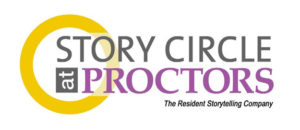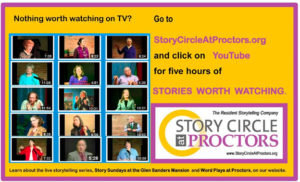September 2011
by Kate Dudding
Five years ago, something exciting happened in our community. (No, that’s not the royal we – I have a producing partner, Alden (Joe) Doolittle. We specialize in producing storytelling events for adults.
Together we’ve produced over 90 storytelling dinner programs and over 10 Tellabrations.) As I was saying, something exciting happened in the Albany/Troy/Schenectady Capital Region of New York State five years ago. A 2,600 seat theatre, Proctors, a 1930s vaudeville theatre refurbished in the late 1970s with a season of 150 performances, was expanding – adding a 400 seat black box theatre, a cozy performance space in the basement and an art gallery which can seat 120.
Proctors is an important part of revitalizing downtown Schenectady. But what was must attractive to us is the theatre crowds that it draws – Lion King was there for a month and 80,000 people came.
Yes, 80,000 people came in one month. The large theatre virtually sold out each performance.
We started to scheme how we could work our way into Proctors and steal, ah, convert some of those theatre goers to story listeners. After all, storytelling was the first performing art. Many people who enjoy theatre also enjoy storytelling. We have a modest goal: steal, ah convert, 250 of those 80,000 people to story listeners.
Proctors is perfect for us because we wanted to follow Producing Rule 1: The venue determines the audience.
(Please note that I learned many of these producing rules by being a member of the National Storytelling Network’s (NSN) Producers Special Interest Group (PRO SIG.) In fact, there’s a collection of articles for producers on their web site https://storynet.org/groups/producers-and-organizers-pro/articles-for-producers/ as well as a free copy of a 77 page Producer’s Guide written in 2000 https://storynet.org/groups/producers-and-organizers-pro/producers-guide/ .
Back to the venue determines the audience. People go to events held at places that they already go to. That’s why SpeakeasyDC uses venues where 20-30 year olds go. Since 80,000 people were already coming to Proctors, many of them adults, Proctors was a good venue for us.
Here are two examples of venues which didn’t work. One festival held an adult event at a children’s museum; not many people came, probably because of the mismatch between the children’s venue and the adult event. Another festival held a family event at a college auditorium. While 100 people did come, only a handful were children, possibly because people saw the college venue and missed seeing the word “family” in the event description.
FYI we never intended, not do we now want, to produce storytelling events in the large theater. For us, storytelling is an intimate art form. We like our storytellers and story listeners to be able to see each other’s faces. The art gallery was just the right size for us.
Luckily when we approached the CEO of Proctors, he had had experience with Charlotte Blake Allston telling stories to adults when heading his previous arts center. He quickly offered, “Why don’t you become the resident storytelling company at Proctors?”
We accepted his offer.
We didn’t even have to mention the storytelling events for adults that we had already produced nor some of the arts centers which already have resident storytelling companies:
- Barbican Centre, London, UK, and The Crick Crack Club
- National Arts Centre, Ottawa, CA, and Ottawa Storytellers
- Glenn Allen Cultural Arts Center, Richmond, VA, and The Tell Tale Hearts
While we pay the non-profit rate for the rooms where we have performances, we have received a lot of extras. For example, Proctors created our logo for us for free:

They sell tickets for us, both online and at their box office, charging us only $2/ticket ($1 of which goes to their restoration fund, as is true for all the tickets they sell.) They created a small step high stage for us in the art gallery, making it easier for our storytellers to be seen. We have three Proctors volunteers at each show: one taking tickets, the other two selling beer, wine and soda before the show and during intermission. In their 16 page, full color season brochure, the resident companies share one of the pages. We do fund and manage our own independent web site: www.storycircleatproctors.org .
Our main events at Proctors are Tellabration and a series for adults called Word Plays. To attract the Proctors theater goers, we followed Producing Rule 2: Use their lingo. With the help of Richard Martin, a storyteller in Germany, and Margie Rosenkranz, director of an independent music collective also resident at Proctors, we developed the following description:
Storytelling is a shared experience between the audience and the performer, combining the intensity of a solo performer with the intimacy of a face-to-face conversation.
So we deliberately use the word “performer” instead of the word “storyteller.” Theatre goers understand “performer” much better than they do “storyteller.”
I learned Producing Rule 3: Become part of the venue in all that it does at the 2007 NSN PRO SIG pre- conference workshop on Theater and Storytelling Collaborations, given by Nancy Donoval and Loren Nieme – see https://storynet.org/workbook-for-theater-and-storytelling-collaborations/
for the extremely valuable handout from this workshop listing all sorts of details that you need to consider. One caution I remember in particular from
that workshop. I paraphrase: “If the theatre loves scenery, do NOT say ‘Storytelling doesn’t need scenery.’ You are joining them at their venue. Be polite and do not spit on their dearly held values.”
To become part of Proctors, I joined the Theatre Guild at Proctors, their fund-raising volunteer auxiliary over 20 years old. When I participate in their activities, I am frequently able to introduce people to our storytelling events at Proctors.
I also became a Facebook friend of Proctors. When I saw that other resident companies were getting Proctors Facebook entries, I suggested some entries about our storytelling events.
After two years, we hadn’t converted a lot of Proctors theater goers to storytelling listeners. So I went to a workshop on collaboration and partnerships, offered by Mary Fellows, producer of the Riverway Storytelling Festival as well as Manager of Youth and Family Services at the nearby Upper Hudson Library System. At that workshop, Mary presented Producing Rule 4: Collaborate with the venue. She cautioned us to remember that a collaboration must be of value to all participants. When I shared our situation at Proctors with her, she suggested pre-show spoken word programs, themed to events on the large stage. Proctors was quite receptive, especially since they already had a theatre talk series before/after the touring Broadway musicals. Here’s Proctors description of our pre-show spoken word series:
The Story Circle Pre-show Spoken Word Program series offers pre-performance arts programs to ticket buyers free of charge. The programs are delivered by professional spoken word artists to engage patrons in a unique forum to extend the theme of a specific show. After the performance, the audience members are encouraged to ask questions, creating a dynamic interaction geared toward increasing awareness about the Arts.
So Proctors views our series as a way to extend the experience for their audience, while we view it as a way to introduce their audience to us and to storytelling. Proctors offers the space for free, setting up chairs and a mic on a stage across from their coffee shop – the same location where they hold their theatre talk series. Our tellers volunteer their time. (Some day we hope to pay them.) Our programs start an hour before curtain time and last 30 minutes, ending just as the theatre is opened for seating. At the last spoken work program last season, 40 people listened to some or all of the stories.
One disappointment was that we could not do programs before the big Broadway shows like Lion King. Proctors’ people told us that these shows are very controlling of the audience’s entire experience
As a way to connect with the audiences at Proctors during our summer hiatus, we posted flyers and left handouts (see below) advertising our YouTube channel:

1,339 stories have been watched during June-August. Hopefully some of those people will now come and see us live. Joe Doolittle and I have had a monthly public access TV show for several years, with a storyteller guest for each show. From our TV show DVDs, I edited out the stories to put on our YouTube channel.
So after four seasons at Proctors, 1,200 people have enjoyed Tellabration, Word Plays and our Pre-show Spoken Word Program. That’s not as many as we had hoped. However, with its expanded facilities, half a million people come to Proctors each season. It’s still the place we want to be. We continue to look for ways to steal, ah, convert Proctors’ theatre goers to our story listeners.
If you want to start a collaboration with an arts center or theatre, I suggest you read the articles on the NSN PRO SIG web site, then join the SIG. The SIG has a listserv where you can ask many experienced producers questions. Also feel free to contact me for some brainstorming and a bit of hand-holding. Our art form always needs more advocates producing events. Why not you?
